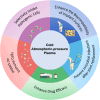Cold Atmospheric Plasma in the Treatment of Autoimmune Diseases: Mechanisms, Applications, and Prospects
- PMID: 40801249
- PMCID: PMC12344578
- DOI: 10.1002/iid3.70245
Cold Atmospheric Plasma in the Treatment of Autoimmune Diseases: Mechanisms, Applications, and Prospects
Abstract
Background: Autoimmune diseases, including rheumatoid arthritis (RA), are characterized by an aberrant immune responses that leads to chronic inflammation and tissue damage. Traditional treatments, such as immunosuppressive drugs, only provide symptomatic relief and often cause significant side effects. Cold atmospheric plasma (CAP), a form of nonthermal plasma, has emerged as a potential therapeutic tool, offering antimicrobial, anti-inflammatory, and immune-modulatory effects.
Objective: This review aims to explore the mechanisms of CAP, its application in autoimmune diseases, and its potential to improve existing treatments.
Methods: The review synthesizes recent studies investigating the biological effects of CAP, particularly its interaction with immune cells. Key mechanisms discussed include the generation of reactive oxygen and nitrogen species (ROS/RNS), which modulate immune responses, promote wound healing, and target pathogenic cells. The therapeutic potential of CAP in treating autoimmune diseases, such as RA, atopic dermatitis, allergic contact dermatitis, psoriasis, and vitiligo is examined through current research findings.
Results: Studies have demonstrated that CAP can modulate fibroblast-like synoviocytes in RA, reducing their viability and inducing apoptosis. In skin diseases like atopic dermatitis, CAP has been shown to alleviate symptoms and reduce microbial load by altering the skin microbiome. In psoriasis, CAP suppresses Th17 cell differentiation and reduces keratinocyte hyperproliferation. Additionally, CAP enhances wound healing by promoting macrophage M2 polarization and collagen remodeling. Despite promising results, concerns remain about the long-term safety of CAP, particularly regarding the accumulation of ROS/RNS.
Conclusion: CAP offers a novel approach for treating autoimmune diseases by modulating immune responses, enhancing drug efficacy, and promoting tissue repair. Its ability to selectively target pathogenic cells and its antimicrobial properties make it a promising therapeutic tool in autoimmune diseases.
Keywords: autoimmune disease; cold atmospheric plasma; inflammation; treatment.
© 2025 The Author(s). Immunity, Inflammation and Disease published by John Wiley & Sons Ltd.
Conflict of interest statement
The authors declare no conflicts of interest.
Figures



Similar articles
-
Prescription of Controlled Substances: Benefits and Risks.2025 Jul 6. In: StatPearls [Internet]. Treasure Island (FL): StatPearls Publishing; 2025 Jan–. 2025 Jul 6. In: StatPearls [Internet]. Treasure Island (FL): StatPearls Publishing; 2025 Jan–. PMID: 30726003 Free Books & Documents.
-
DS-Modified Paeoniflorin pH-Responsive Lipid-Polymer Hybrid Nanoparticles for Targeted Macrophage Polarization in a Rat Model of Rheumatoid Arthritis.Int J Nanomedicine. 2025 Jul 12;20:8967-8992. doi: 10.2147/IJN.S516434. eCollection 2025. Int J Nanomedicine. 2025. PMID: 40671689 Free PMC article.
-
Management of urinary stones by experts in stone disease (ESD 2025).Arch Ital Urol Androl. 2025 Jun 30;97(2):14085. doi: 10.4081/aiua.2025.14085. Epub 2025 Jun 30. Arch Ital Urol Androl. 2025. PMID: 40583613 Review.
-
The Black Book of Psychotropic Dosing and Monitoring.Psychopharmacol Bull. 2024 Jul 8;54(3):8-59. Psychopharmacol Bull. 2024. PMID: 38993656 Free PMC article. Review.
-
Ophthalmia Neonatorum.2025 Jul 7. In: StatPearls [Internet]. Treasure Island (FL): StatPearls Publishing; 2025 Jan–. 2025 Jul 7. In: StatPearls [Internet]. Treasure Island (FL): StatPearls Publishing; 2025 Jan–. PMID: 31855399 Free Books & Documents.
References
-
- Shalom Eliezer Y. E., The Fourth State of Matter: An Introduction to Plasma Science, 2nd Edition. 2001.
-
- Zhao Y., Liu Y., Liu Z., et al., “A 3D‐printed Fence‐Surface Plasma Source for Skin Treatment and Its Potential for Personalized Medical Application,” Journal of Physics D: Applied Physics 57, no. 12 (2024): 125207.
-
- Sheng X., Wang J., Zhao L., et al., “Inactivation Mechanism of Cold Plasma Combined With 222 nm Ultraviolet for Spike Protein and Its Application in Disinfecting of SARS‐CoV‐2,” Journal of Hazardous Materials 465 (2024): 133458. - PubMed
-
- Zhang Y., Chen Z., Shao C., and Huang Q., “Study of the Effect of Shock Wave From a Portable Pulsed Cold Air Plasma Jet Device on Inactivation of Trichophyton Rubrum in Nails,” Applied Physics Letters 124, no. 24 (2024): 243701.
Publication types
MeSH terms
Substances
LinkOut - more resources
Full Text Sources
Medical
Miscellaneous

